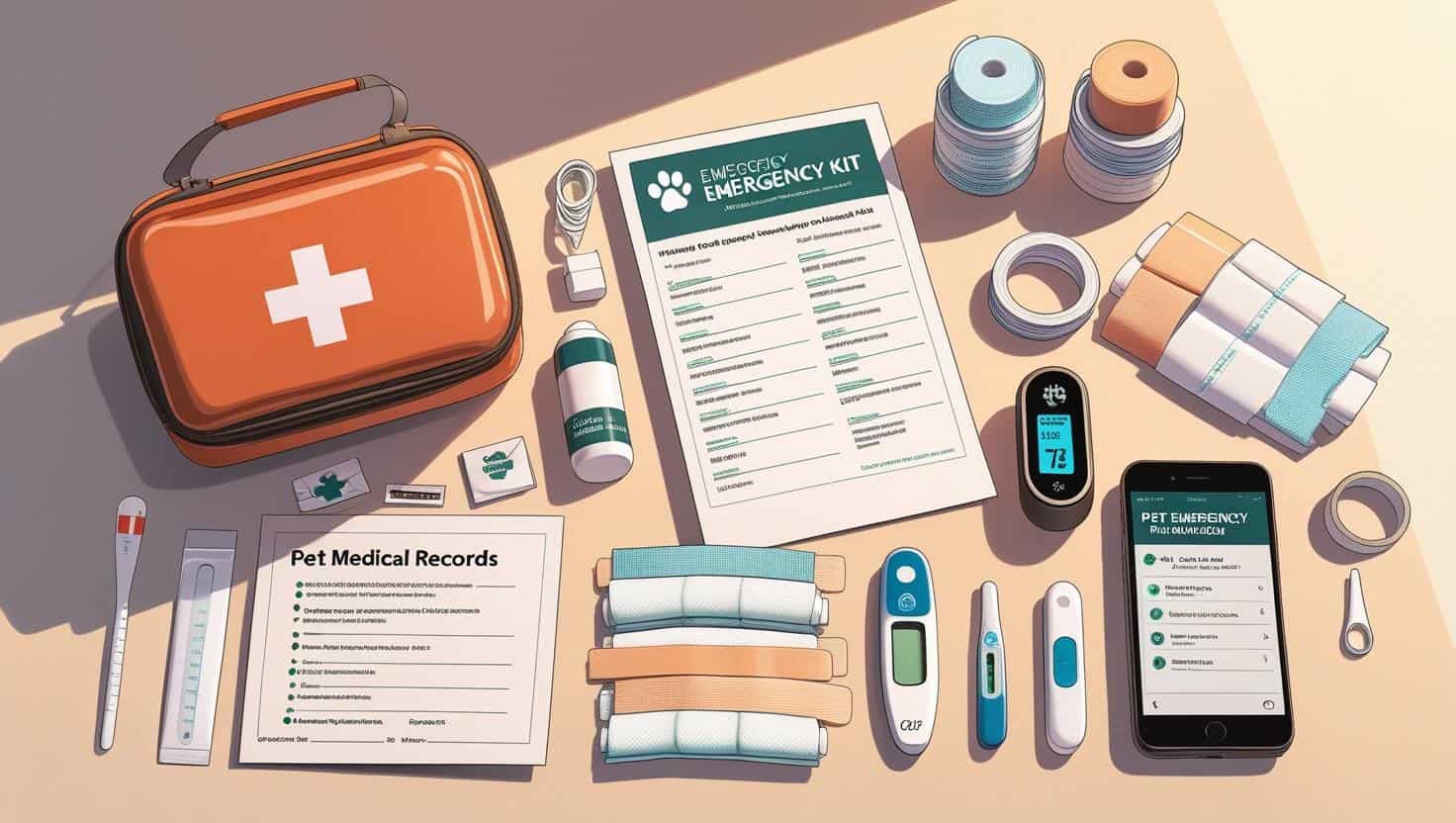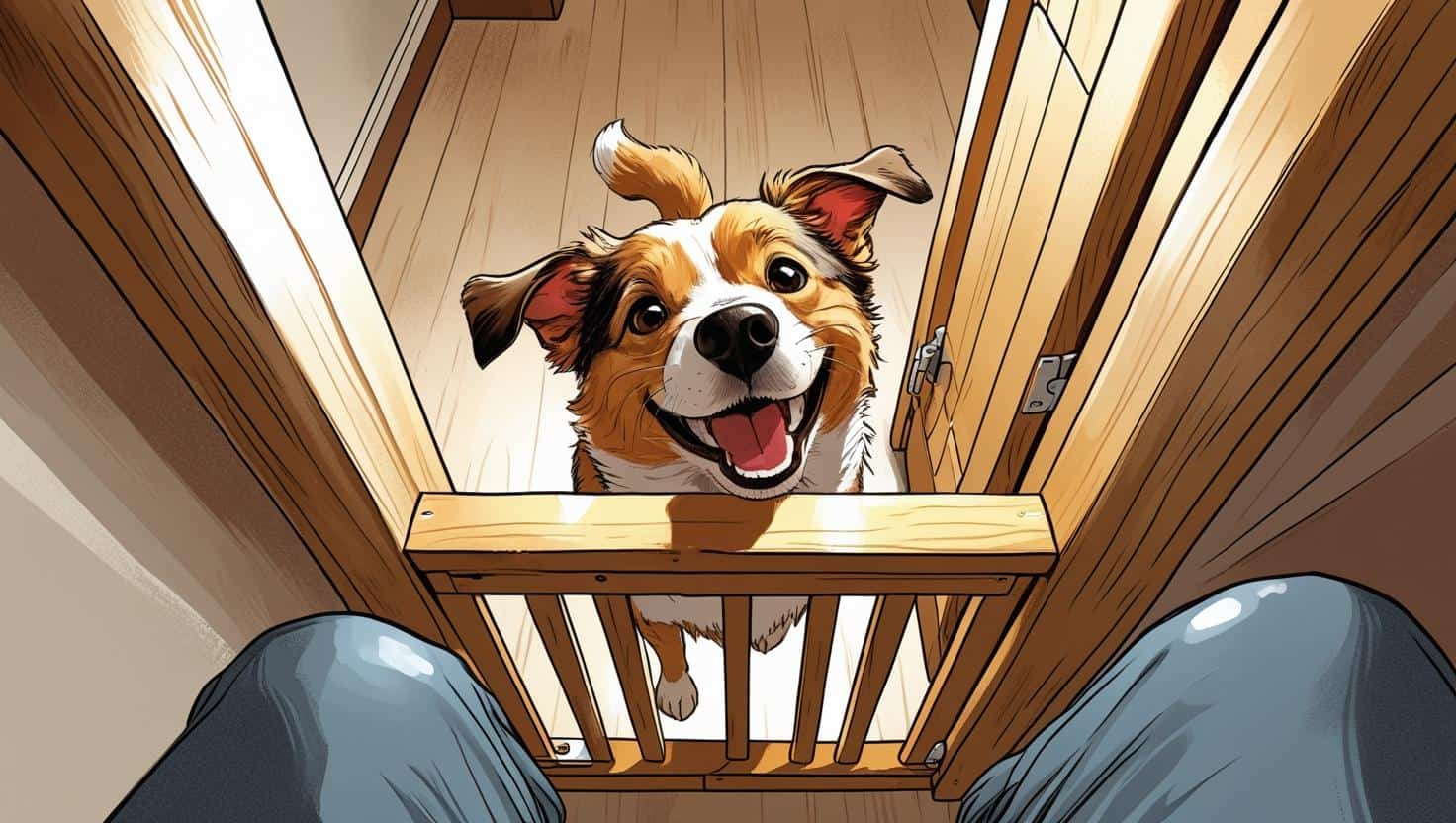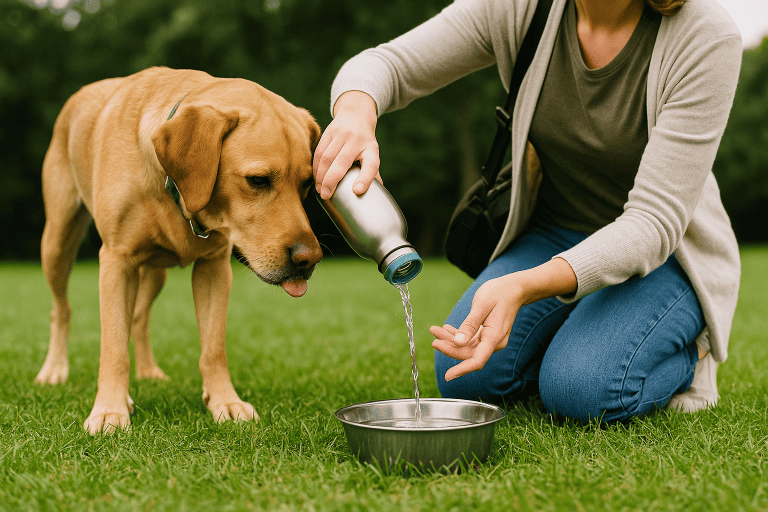How to Handle Pet Sitting Emergencies Like a Pro

Let’s put this right here at the start:
If you are in any doubt at all about the health of a pet in your care, contact a vet immediately.
According to the RSPCA, over 60% of pet emergencies happen when owners aren’t home. That’s where you come in. Whether you’re watching your neighbour’s cat or running a professional pet sitting service, knowing how to handle emergencies isn’t just helpful—it’s necessary.
Don’t panic. Every crisis has a solution. This guide will turn you from a worried pet sitter into a confident caregiver who’s ready for anything.
Want to know more about the ins and outs of pet sitting in general? Check out this ultimate guide!
Recognising Common Pet Emergencies Fast

Time matters when pets are in danger. A few seconds can mean the difference between a minor scare and a life-threatening situation. Most pet sitters feel confident handling basic care, but recognising true emergencies? That’s where things get tricky.
You don’t need veterinary training to spot the warning signs. What you need is a clear understanding of what normal looks like versus what demands immediate action.
Signs That Need a Vet Right Now
Breathing problems: Watch for open-mouth breathing in cats, blue-tinged gums, or any laboured breathing that lasts more than a few minutes. Dogs pant normally, but cats rarely breathe with their mouths open unless something’s wrong.
Severe bleeding: Any cut that won’t stop bleeding after 5 minutes of direct pressure needs professional attention. Blood that spurts rather than flows steadily indicates arterial bleeding – this requires emergency care.
Loss of consciousness: If a pet collapses and won’t respond to their name or gentle touches, get to a vet immediately. Seizures lasting longer than 2 minutes also fall into this category.
Bloated stomach: In dogs, especially large breeds, a swollen, hard belly combined with retching but no vomit can signal gastric torsion. This condition kills within hours if left untreated.
Temperature extremes: A rectal temperature above 39.4°C (103°F) or below 37.2°C (99°F) in dogs and cats indicates serious trouble.
Spotting Breathing Problems and Choking
Choking happens faster than you think. One minute your pet’s playing happily, the next they’re pawing at their mouth in panic.
Choking signs: Look for excessive drooling, pawing at the face, blue or pale gums, and that distinctive panicked look in their eyes. You might hear wheezing or see them trying to cough but nothing comes up.
Breathing distress signals: Rapid, shallow breathing when the pet hasn’t been active is a red flag. So is breathing that sounds wet or congested when they don’t have a cold.
Dogs experiencing breathing problems often stand with their front legs spread wide and their head extended. Cats hide their breathing issues better, but watch for them sitting hunched over with their neck stretched out.
What normal breathing looks like: Healthy dogs take 10-30 breaths per minute at rest. Cats breathe slightly faster at 20-30 breaths per minute. Count chest rises for 15 seconds and multiply by four to get their rate.
Reading Pet Body Language During Distress
Animals can’t tell you what hurts, but their bodies speak volumes. Learning this silent language could save a life.
Pain signals: A pet in pain often becomes unusually quiet or hides in spots they normally avoid. They might pant excessively, pace restlessly, or assume unusual positions. Dogs may pray bow (front end down, rear up) when their stomach hurts.
Fear versus pain: Scared pets usually try to escape or hide but remain alert. Pets in pain focus inward and may not respond to their favourite treats or your voice.
Subtle signs people miss: Watch the eyes. Pets in distress often have dilated pupils or a glazed expression. Their ears might be pinned back even when you’re not scolding them.
Behaviour changes: A normally social pet who suddenly wants to be alone might be telling you something’s wrong. The opposite also applies – clingy behaviour from an independent pet can signal distress.
Trusting Your Instincts and Acting Fast
That gut feeling you get when something seems off? Trust it. Pet sitters who’ve been doing this for years often say their instincts kicked in before they consciously recognised the problem.
The 5-minute rule: If you’re questioning whether something needs veterinary attention, observe the pet for 5 minutes maximum. If the concerning behaviour continues or worsens, make the call.
Document everything: Note the time symptoms started, what the pet was doing beforehand, and any changes you observe. Vets appreciate this information, and it helps you explain the situation clearly to worried owners. Consider investing in a pet camera – video evidence is is valuable.
Don’t wait for permission: If you can’t reach the pet’s owner and you’re seeing emergency signs, go to the vet. Most pet parents would rather pay an unnecessary vet bill than lose their companion because you hesitated.
Creating Your Mental Emergency Checklist
Professional pet sitters develop a mental routine that helps them assess situations quickly. Here’s how to build yours:
Step 1: Is the pet responsive? Call their name and see if they acknowledge you.
Step 2: Check their breathing. Is it normal rate and effort?
Step 3: Look at their gums. Pink and moist is good. White, blue, or bright red signals trouble.
Step 4: Observe their posture and movement. Are they moving normally or favouring a limb?
Step 5: Note any discharge from eyes, nose, or other openings.
This entire assessment should take less than 60 seconds. Practice it on healthy pets so it becomes automatic when emergencies strike.
Most pet emergencies are manageable when caught early. The pets in your care depend on your vigilance and quick thinking. By learning to recognise these warning signs, you’re already ahead of most pet sitters who simply hope nothing goes wrong.
Building Your Pet Emergency Action Plan

Being prepared isn’t about expecting the worst. It’s about having confidence when unexpected situations arise. The difference between a panicked pet sitter and a calm, collected one often comes down to preparation.
Smart preparation starts before the owners walk out the door. Once you’ve gathered the right information and supplies, you’ll handle any emergency with the composure pets need from you.
Getting the Right Information From Pet Owners
Medical history: Ask about any ongoing health conditions, recent illnesses, or surgeries. A dog recovering from surgery might show different symptoms than a healthy one experiencing a new problem.
Current medications: Write down exact names, dosages, and timing. Some medications can cause side effects that look like emergencies but aren’t. Others can’t be missed without serious consequences.
Previous emergency episodes: Has this pet had seizures before? Do they get into things they shouldn’t? Past behaviour often predicts future incidents.
Behavioural quirks: Some pets hide when scared, others become aggressive when in pain. Knowing their normal stress responses helps you read emergency situations better.
Insurance information: Get policy numbers and contact details. Many pet insurance companies have 24-hour helplines that can guide you through emergencies.
Building Complete Emergency Contact Lists
Your phone should have these numbers saved before you need them. Scrambling to find contact information during a crisis wastes precious time.
Primary vet: Get the main number, after-hours number, and exact address. Some practices have multiple locations – know which one to use.
Emergency animal hospital: Find the nearest 24-hour facility and program their address into your phone’s GPS. Drive there once during a non-emergency so you know the route.
Pet owners: Get at least two phone numbers. If they’re travelling internationally, find out the best times to reach them and any time zone differences.
Backup contacts: The owner’s friend, family member, or regular pet sitter who knows this animal. Sometimes they can provide medical history or just reassure a stressed pet.
Pet poison helpline: The ASPCA Animal Poison Control Centre (US: 1-888-426-4435) provides 24-hour guidance. There may be a fee, but it’s worth having the number ready.
Assembling Your Pet First Aid Kit
A basic first aid kit doesn’t replace veterinary care, but it helps you manage situations until professional help arrives. Keep supplies in a clearly labelled container that travels with you.
Bandaging supplies: Gauze pads, medical tape, and elastic bandages for wound care. Self-adhesive bandages work well because they stick to themselves, not fur.
Cleaning materials: Sterile saline solution for flushing wounds and eyes. Avoid hydrogen peroxide unless specifically advised by a vet – it can damage tissue.
Temperature monitoring: A digital rectal thermometer and petroleum jelly for lubrication. Normal temperatures: dogs 38-39.2°C (100.5-102.5°F), cats 38-39.2°C (100.4-102.5°F).
Emergency medications: Only those specifically provided by the owner with clear instructions. Never give human medications without veterinary guidance.
Tools: Tweezers for removing splinters, nail clippers, and a small torch. A towel for restraining frightened animals safely.
Locating Emergency Veterinary Services
Map out options: Identify at least two emergency clinics in case your first choice is full or closed. Save their addresses in your phone and note any special requirements (like calling ahead).
Understand costs: Emergency visits cost more than regular appointments. Know whether the owner has set spending limits or if they expect you to authorize necessary treatment.
Learn their protocols: Some emergency clinics want you to call before arriving. Others operate on a first-come, first-served basis. Knowing their system saves time when minutes count.
Check speciality services: Does the clinic have surgical facilities? Can they do blood work on-site? For serious emergencies, you want comprehensive care available.
Organising Pet Medical Records and Insurance
Keep copies accessible: Photograph vaccination records, medical history, and insurance cards. Store these in your phone so they’re available even if you forget paperwork.
Understand coverage limits: Some insurance policies require pre-approval for expensive treatments. Others cover emergencies but not pre-existing conditions.
Know payment responsibilities: Are you expected to pay upfront and get reimbursed? Can the owner authorize payment over the phone? Clear this up beforehand.
Document everything: Take photos of any injuries, note times and symptoms, and keep receipts. Insurance companies and owners appreciate thorough documentation.
Preparation gives you confidence, and confidence helps pets stay calmer during stressful situations. They pick up on your energy, so the more prepared you feel, the better you can help them through tough moments.
Life-Saving First Aid Every Pet Sitter Must Know

First aid isn’t about playing vet. It’s about keeping pets stable until professional help takes over. These techniques can mean the difference between life and death, but they should never replace proper veterinary care.
Practice these skills on healthy, calm pets so your muscle memory kicks in during real emergencies. The worst time to learn a new technique is when a life depends on it.
Step-by-Step Choking Rescue for Dogs and Cats
Choking kills quickly, but most objects can be removed with the right approach. Stay calm – pets pick up on your panic and become harder to help.
For small dogs and cats: Hold them with their back against your chest. Place your hands just below the ribcage and push firmly upward and forward. Check the mouth after each attempt.
For large dogs: Don’t try to pick them up. Place your hands on either side of the ribcage and push firmly upward and forward. You can also lift their hind legs while pushing on their belly.
Check the mouth: Open it carefully and look for the object. Use tweezers or pliers to remove visible items, but don’t blindly sweep with your fingers – you might push the object deeper.
Alternative technique: Turn small pets upside down and give firm back blows between the shoulder blades. For large dogs, lift their hind legs and give sharp blows to the back.
When to stop: If the pet becomes unconscious, get to a vet immediately. Continue rescue breathing if you know how, but transport them while performing CPR.
Safe Wound Care and Bleeding Control
Direct pressure: Apply clean gauze or cloth directly to the wound and press firmly. Don’t peek – lifting the bandage disrupts clot formation. Maintain pressure for at least 5 minutes.
Pressure points: If direct pressure isn’t working, apply pressure to arteries above the wound. For leg injuries, press on the inside of the thigh where you can feel the pulse.
Bandaging technique: Wrap gauze around the wound, not too tight. You should be able to slip one finger under the bandage. Secure with medical tape, not rubber bands or string.
What not to do: Don’t use hydrogen peroxide or alcohol on deep wounds. Don’t remove objects stuck in wounds – stabilise them and get to a vet. Don’t use human antiseptic creams unless approved by a veterinarian.
Signs you need help: Bleeding that soaks through multiple bandages, wounds longer than 2.5cm, or any injury that gapes open needs professional stitching.
Responding to Poisoning Incidents
Don’t induce vomiting: This used to be standard advice, but many substances cause more damage coming back up. Call a poison helpline or vet first.
Identify the substance: Take the package with you to the vet. If the pet vomited, collect a sample in a sealed container. Time matters, but identification matters more.
Common household dangers: Chocolate (especially dark), grapes, onions, xylitol (sugar substitute), and human medications top the list. Even small amounts can be dangerous.
Activated charcoal: Some vets recommend this for certain poisons, but only give it under professional guidance. The wrong timing can make it useless or harmful.
Rinse external exposure: If chemicals touch the skin or eyes, rinse with lukewarm water for at least 10 minutes. Don’t use hot water – it can increase absorption.
Managing Seizures Until Help Arrives
Seizures look terrifying, but most last less than 2 minutes and don’t cause permanent damage. Your job is keeping the pet safe, not stopping the seizure.
Create a safe space: Move objects that could cause injury. Don’t try to move the pet unless they’re in immediate danger from traffic or other hazards.
Don’t restrain them: Never hold down a seizing animal or put anything in their mouth. They won’t swallow their tongue, but they might bite you accidentally.
Time the seizure: Note when it starts and ends. If you can, record the seizure on your phone, for timing and to show the vet, should they want to assess it.
Post-seizure care: Pets are often confused and disoriented afterward. Speak softly, keep lights dim, and give them space to recover. Some may be temporarily blind or deaf.
Multiple seizures: If seizures repeat within 24 hours, get veterinary help even if each individual episode is short.
Basic Pet CPR Techniques
CPR rarely saves pets, but it can buy time until you reach emergency care. Only attempt this if the pet is unconscious and not breathing.
Check for pulse: Feel inside the thigh where the leg meets the body. If you find a pulse, don’t do chest compressions.
Chest compressions: For small pets, use one hand. For large dogs, use both hands or just the heel of one hand. Press down 1/3 to 1/2 the width of the chest.
Compression rate: Aim for 100-120 compressions per minute. Count “1 and 2 and 3 and…” to maintain rhythm.
Rescue breathing: Close the pet’s mouth and breathe into their nose. Give 2 breaths for every 30 compressions. Watch for the chest to rise with each breath.
When to stop: If the pet starts breathing or you detect a pulse, stop compressions but continue rescue breathing if needed. If there’s no response after 10 minutes, the chance of recovery is minimal.
Remember: First aid buys time, but it doesn’t replace professional veterinary care. Use these techniques to stabilise pets until you can get them to qualified help.
Handling Medical Emergencies with Confidence

Medical emergencies test your decision-making skills more than your hands-on abilities. Knowing when to act, when to wait, and when to rush to the vet can literally save lives.
The best pet sitters learn to read situations quickly and communicate clearly with veterinary professionals. Your observations and actions in the first few minutes often determine the outcome.
Recognising Serious Medical Conditions
Gastric bloat in dogs: A hard, swollen belly combined with unproductive retching signals a life-threatening emergency. Large, deep-chested breeds face the highest risk. The stomach twists, cutting off blood supply. You have hours, not days, to get help.
Heatstroke symptoms: Heavy panting, drooling, weakness, and vomiting in hot weather. A rectal temperature above 40°C (104°F) requires immediate cooling and veterinary care. Don’t use ice – cool water works better.
Allergic reactions: Facial swelling, hives, difficulty breathing, or sudden collapse after exposure to new foods, medications, or insect stings. Severe reactions can kill within minutes.
Diabetic emergencies: Too much or too little insulin causes different but equally serious problems. High blood sugar develops over days, but low blood sugar can cause seizures within hours.
Urinary blockages: Male cats are especially vulnerable. Straining in the litter box, crying, or producing no urine despite trying indicates a complete blockage. This kills within 24-48 hours if untreated.
Dealing with Eating, Drinking, and Toilet Issues
Not eating: Healthy pets rarely skip more than one meal. Cats can develop life-threatening liver problems after just 3-4 days without food. Dogs can go longer, but appetite loss often signals underlying illness.
Excessive drinking: Sudden increases in water consumption (more than 100ml per kg of body weight daily) can indicate diabetes, kidney disease, or other serious conditions.
Diarrhoea and vomiting: Single episodes aren’t usually emergencies, but blood in vomit or stool, repeated episodes, or signs of dehydration require veterinary attention.
Constipation concerns: Dogs and cats should defecate at least once every 48 hours. Straining without producing anything, especially in cats, might indicate blockages.
Dehydration testing: Gently pinch the skin on the back of the neck. It should snap back immediately. Slow return indicates dehydration severe enough to need professional fluid therapy.
Managing Diabetic Pet Emergencies
Low blood sugar signs: Weakness, confusion, trembling, or loss of coordination. The pet might act drunk or unresponsive. This progresses to seizures and coma without treatment.
Emergency glucose: If the pet is conscious and can swallow, rub honey or corn syrup on their gums. Don’t pour it down their throat if they’re unconscious – they could choke.
High blood sugar symptoms: Excessive urination, drinking, and a sweet smell to their breath. This develops slowly but still needs veterinary attention the same day.
Insulin mistakes: Too much insulin causes low blood sugar. Too little allows blood sugar to rise dangerously. Never guess about insulin doses – follow written instructions exactly.
When to skip insulin: If a diabetic pet isn’t eating normally, contact the vet before giving their usual insulin dose. The medication might cause dangerous drops in blood sugar.
Medication Overdoses and Missed Doses
Signs of overdose: Vomiting, diarrhoea, lethargy, confusion, or any behaviour that’s unusual for this pet. Some medications cause specific symptoms – heart medications might slow or speed up heart rate.
What to bring to the vet: The medication bottle, any remaining pills (so they can count), and a sample of vomit if the pet brought up pills.
Missed dose protocols: Some medications must be given exactly on schedule. Others can be given late or skipped entirely. Get specific instructions for each medication before the owners leave.
Never double up: If you’re not sure whether the pet got their medication, don’t give another dose. It’s usually safer to skip one dose than to accidentally double it.
Human medication dangers: Dogs and cats process many human drugs differently than we do. Ibuprofen, paracetamol, and many prescription medications can kill pets even in small doses.
Communicating with Emergency Vets
Have information ready: Pet’s name, age, breed, weight, current medications, and the owner’s contact information. Emergency vets need this before they can help.
Describe symptoms clearly: When did they start? Are they getting worse? What exactly does the behaviour look like? “Acting strange” doesn’t help – be specific.
Ask about transport: Should you bring the pet in immediately, or can you monitor them at home? Some conditions require immediate attention, others can wait for regular vet hours.
Understand costs: Emergency visits cost £200-£2000 depending on the problem. Know whether the owner has set spending limits or if they want you to authorize necessary treatment.
Take notes: Write down the vet’s instructions. Emergency situations create stress, and it’s easy to forget important details.
Medical emergencies feel overwhelming, but remember that you’re not diagnosing or treating – you’re observing, stabilising, and getting professional help. Trust your observations and don’t hesitate to seek veterinary guidance when something feels wrong.
Handling Behavioural Emergencies and Escape Situations

Not all emergencies involve illness or injury. Sometimes the crisis is a terrified cat hiding under a bed or a dog that’s bolted through an open door. These situations need different skills but equal urgency.
Behavioural emergencies often happen when pets are already stressed by their owners’ absence. Your calm, confident approach can prevent minor incidents from becoming major problems.
Managing Aggressive or Fearful Pets
Fear aggression signs: Growling, snapping, or biting combined with cowering, trembling, or attempts to hide. These pets aren’t mean – they’re terrified and defending themselves.
Don’t corner them: Give frightened pets an escape route. Trapped animals often bite because they see no other option. Move slowly and avoid direct eye contact.
Use barriers: Baby gates, thick towels, or even furniture can help you manage an aggressive pet safely. Don’t try to grab or restrain them with your bare hands.
Calming techniques: Soft, slow talking often helps. Avoid high-pitched voices or excited tones. Some pets respond well to being ignored – your attention might be adding to their stress.
When to call for help: If you can’t safely approach the pet for feeding, medication, or basic care, contact the owner or a professional. Don’t risk serious injury trying to be a hero.
Safe Techniques for Handling Panicked Animals
Towel restraint: Large, thick towels can safely restrain cats and small dogs. Wrap them snugly but not tightly – you want to prevent movement, not restrict breathing.
Slip leads for dogs: Even friendly dogs might panic during emergencies. A slip lead gives you control without having to grab their collar or risk being bitten.
Slow movements: Quick movements trigger chase instincts in many animals. Move deliberately and speak in calm, low tones. Your energy directly affects their stress level.
Safe zones: Create spaces where stressed pets can retreat and calm down. This might be their usual hiding spot or a quiet room with their favourite blanket.
Medication considerations: Some pets take anti-anxiety medications regularly. Others might need emergency sedation from a vet if they’re dangerously panicked.
Emergency Protocols for Escaped Pets
Act immediately: The first 2-4 hours are critical. Pets are usually still close to home and haven’t travelled far. Quick action dramatically improves recovery chances.
Search systematically: Start within a 1-mile radius and work outward. Check under porches, in garages, and anywhere a scared pet might hide. Bring their favourite treats and speak in normal tones.
Notify key people: Contact the owners immediately, then local vets, animal shelters, and dog wardens. Many escaped pets are picked up by well-meaning people and taken to these facilities.
Use technology: Post on local Facebook groups, Nextdoor, and lost pet websites. Include recent photos, exact location last seen, and your contact information.
Leave familiar items outside: Put their bedding, your worn clothing, or the owner’s clothes outside. Familiar scents can guide them home. Don’t put food out – it attracts other animals.
Using Social Media and Local Networks
Facebook groups: Most areas have lost pet groups with thousands of members. Post immediately with clear photos, location details, and contact information.
Physical posters: Place them at veterinary clinics, pet shops, and community bulletin boards. Include a recent photo and keep text brief and clear.
Door-to-door searches: Ask neighbours to check their garages, sheds, and basements. Scared pets often hide in the first safe space they find.
Professional help: Pet detectives and tracking services exist in many areas. They have specialized equipment and experience that dramatically improves success rates.
Timeline matters: Most pets are found within 24-48 hours or not at all. Maintain intensive search efforts during this critical window.
Preventing Trauma During Stressful Situations
Stay calm yourself: Pets mirror your emotional state. If you’re panicking, they’ll panic more. Deep breaths and steady movements help everyone stay calmer.
Maintain routines: Keep feeding times, walks, and other regular activities as normal as possible. Familiar routines provide security during stressful periods.
Limit exposure: Don’t let curious neighbours or children overwhelm a stressed pet. They need quiet, predictable interactions until they settle down.
Monitor for signs: Some pets develop lasting anxiety after traumatic events. Watch for changes in appetite, sleep patterns, or behaviour that persist after the immediate crisis ends.
Document everything: Take photos of injuries, note behaviour changes, and keep records of veterinary visits. This information helps owners and future sitters understand the pet’s needs.
Behavioural emergencies test your patience more than your medical knowledge. Remember that most scared or aggressive pets are responding normally to abnormal situations. Your job is creating safety for everyone involved, not fixing their emotional state in one visit.
Communication During Crisis Moments

Clear communication during emergencies can mean the difference between a manageable situation and a complete disaster. You’re often the bridge between panicked pet owners and busy veterinary staff, and your ability to share information clearly affects everyone’s decisions.
Emergency communication isn’t just about relaying facts. It’s about managing emotions, setting expectations, and helping everyone make the best choices for the pet’s wellbeing.
Contacting Pet Owners During International Emergencies
Time zones matter: Calculate the time difference before calling. A 3 AM panic call about a minor issue won’t help anyone, but a serious emergency justifies waking someone up.
Multiple contact methods: Try calling first, then text, then email. Some countries have poor phone service but reliable internet. WhatsApp often works when regular calls don’t.
Be prepared for delays: International calls might not go through immediately. Have a backup plan for emergency decisions that can’t wait for owner approval.
Consider local contacts: The owners might have family or friends in your area who can make decisions on their behalf. Get these contact details before emergencies happen.
Document your attempts: Keep records of when you tried to contact them and which methods you used. This protects you if owners later claim they weren’t notified promptly.
Essential Information for Veterinary Staff
Pet identification: Name, age, breed, weight, and any distinguishing markings. Some practices see dozens of animals daily – help them identify your patient correctly.
Current medications: Exact names, dosages, and when the last dose was given. Don’t guess – bring the bottles if you have them. Some medications interact dangerously with emergency treatments.
Medical history: Ongoing conditions, recent illnesses, surgeries, or injuries. A pet recovering from surgery might show different symptoms than a healthy one with a new problem.
Symptom timeline: When did you first notice the problem? Is it getting worse, staying the same, or improving? This information helps vets prioritize treatment.
Owner contact information: Phone numbers, current location, and any spending limits they’ve set. Emergency vets need authorization for expensive treatments.
Documenting Incidents for Insurance and Peace of Mind
Photo evidence: Take pictures of injuries, damaged property, or anything unusual. Visual evidence supports insurance claims and helps owners understand what happened.
Timeline records: Note exact times when symptoms started, when you contacted various people, and when treatments were given. Insurance companies appreciate detailed records.
Witness information: If others saw the incident or helped with the emergency, get their contact details. Their statements might support insurance claims later.
Veterinary reports: Request copies of all medical records, treatment plans, and discharge instructions. These become part of the pet’s permanent health history.
Expense tracking: Keep receipts for emergency vet visits, medications, and any supplies you purchased. Most pet owners reimburse these costs promptly when properly documented.
Managing Your Emotions While Staying Professional
It’s normal to feel stressed: Emergencies trigger adrenaline responses in humans too. Acknowledge your feelings, but don’t let them control your actions.
Focus on facts: When talking to owners or vets, stick to what you observed rather than your interpretations. “The dog vomited three times in two hours” is more helpful than “I think he’s really sick.”
Take breaks when possible: If the situation allows, step outside for a few deep breaths. A few minutes of fresh air can help you think more clearly.
Don’t take responsibility for outcomes: You’re providing care, not guaranteeing results. Some situations have bad outcomes despite excellent care – that’s not your fault.
Ask for support: Don’t hesitate to call experienced pet sitters, veterinary staff, or the owners for guidance. Professional help is available when you need it.
Follow-Up Communication After Emergencies
Immediate updates: As soon as the emergency stabilizes, contact the owners with a brief update. They’re probably anxious and appreciate knowing the current status.
Detailed reports: Within 24 hours, provide a written summary of what happened, what treatment was given, and what ongoing care is needed. Email works well for this.
Ongoing monitoring: If the pet needs continued observation or medication, send regular updates. A quick text saying “medication given on schedule, eating normally” provides valuable peace of mind.
Recovery progress: Let owners know when their pet returns to normal behaviour. “Back to begging for treats and sleeping in his favourite spot” tells them more than “doing well.”
Lessons learned: If changes in routine or environment could prevent similar emergencies, share these insights. Constructive suggestions help owners improve their pet’s safety.
Good communication during emergencies builds trust and confidence. Pet owners who feel informed and supported are more likely to recommend your services and use you again. More importantly, clear communication helps ensure pets get the best possible care when they need it most.
Prevention Strategies That Save Lives

The best emergencies are the ones that never happen. Smart prevention doesn’t just keep pets safer – it makes your job as a pet sitter much easier and less stressful.
Most pet emergencies follow predictable patterns. Dogs eat things they shouldn’t. Cats hide when scared and sometimes get stuck. Prevention means thinking ahead about these common scenarios and taking simple steps to avoid them.
Pet-Proofing Homes Before Owners Leave
Kitchen hazards: Secure cabinets containing cleaning supplies, medicines, or food that’s toxic to pets. Many pets become braver about counter-surfing when their owners aren’t home.
Bathroom dangers: Toilet bowl cleaners, medications, and small objects like hair ties pose serious risks. Keep bathroom doors closed or use childproof latches on cabinets.
Living area risks: Electrical cords, small decorative objects, and houseplants need attention. Bored pets often chew things they normally ignore.
Laundry and utility rooms: Detergents, fabric softeners, and antifreeze are highly toxic. Even small amounts can kill pets. Store these in sealed cabinets or high shelves.
Garage and garden hazards: Fertilizers, pesticides, and automotive fluids pose serious dangers. Check for mouse or rat poison – these products kill pets regularly.
Spotting Early Warning Signs of Health Problems
Appetite changes: Most healthy pets eat consistently. Sudden increases or decreases in appetite often signal underlying problems before other symptoms appear.
Energy level shifts: A normally active pet who becomes lethargic, or a calm pet who becomes restless, might be telling you something’s wrong.
Bathroom habit changes: Frequency, consistency, and location of urination and defecation provide important health clues. Note any changes from the pet’s normal patterns.
Sleep pattern disruptions: Pets who suddenly sleep much more or much less than usual might be compensating for illness or pain.
Grooming behaviour: Cats who stop grooming often feel unwell. Dogs or cats who groom excessively might have skin problems, allergies, or anxiety.
Maintaining Proper Care Routines
Feeding schedules: Stick to the owner’s timing and portions. Free-feeding might seem easier, but scheduled meals help you monitor appetite and prevent food-related emergencies.
Exercise requirements: Adequate exercise prevents destructive behaviour and helps maintain physical health. Under-exercised pets are more likely to get into trouble.
Medication timing: Set phone alarms for medication doses. Missing doses or giving them late can cause serious health problems in pets with chronic conditions.
Fresh water access: Clean, fresh water should always be available. Dehydration develops quickly and makes pets more vulnerable to other health problems.
Environmental enrichment: Bored pets create their own entertainment, often in destructive ways. Provide appropriate toys and activities to keep them occupied.
Building Trust to Reduce Stress-Related Incidents
Calm introductions: Spend time letting pets get comfortable with you before their owners leave. Stressed pets are more likely to escape, hide, or become aggressive.
Consistent interactions: Use the same tone of voice, approach patterns, and handling techniques each time you visit. Predictability reduces anxiety.
Respect boundaries: Some pets need space to feel secure. Don’t force interactions with shy or nervous animals – let them come to you when ready.
Maintain familiar routines: Keep feeding times, walk routes, and play sessions as close to normal as possible. Familiar patterns provide security during owner absence.
Create positive associations: Bring special treats or engage in enjoyable activities when you arrive. Help pets associate your presence with good things happening.
Creating Safe Spaces for Anxious Pets
Quiet retreat areas: Identify where each pet goes when stressed and make sure these spaces remain accessible. Don’t block access to their favorite hiding spots.
Comfort items: Leave owner-scented clothing or blankets in the pet’s preferred resting areas. Familiar smells help reduce separation anxiety and provide emotional security.
Noise management: Keep televisions or radios at normal volumes to mask outside sounds that might startle nervous pets. Sudden silence can be as stressful as loud noises.
Safe room setup: For extremely anxious pets, prepare a small room with food, water, litter box (for cats), and comfort items. This gives them complete control over their environment.
Calming aids: Some pets benefit from anxiety wraps, pheromone diffusers, or calming music. Ask owners what works for their pet and keep these tools available.
Multiple escape routes: Anxious pets feel trapped when they can only exit a room one way. Keep doorways clear and provide multiple retreat options.
Prevention isn’t about eliminating every possible risk – that’s impossible. It’s about reducing the most common dangers and creating environments where pets feel secure and comfortable. When pets feel safe, they make better decisions and are less likely to panic during unusual situations.
The time you invest in prevention pays dividends when real emergencies happen. A pet who trusts you and feels secure in their environment is much easier to help during a genuine crisis.
Top 3 Pet First Aid Courses in the UK for Dog Walkers and Pet Sitters
Here are three of the best UK-based pet first aid courses tailored for pet care professionals:
- Dog First Aid Training – Emergency Canine First Aid Course
This vet-led course is specifically designed for dog professionals. It covers everything from CPR and choking to bleeding and heatstroke. With both in-person and online options, it’s perfect for busy pet sitters and dog walkers.
Website: dog-first-aid.com - PDSA – Pet First Aid Awareness Course
Offered by one of the UK’s leading veterinary charities, this online course is ideal for those looking to gain essential first aid knowledge at their own pace. Topics include common pet emergencies, injury prevention, and when to seek veterinary help.
Website: pdsa.org.uk - ProTrainings UK – Pet First Aid Level 2 (VTQ)
This CPD-certified course is ideal for dog walkers, pet sitters, and groomers. It covers first aid for dogs and cats, including CPR, poisoning, burns, and more. Available online or as a blended course with practical training.
Website: propetfirstaid.co.uk
Conclusion

Emergencies test every pet sitter’s resolve. But with proper preparation, quick thinking, and the right knowledge, you can handle any crisis that comes your way. The pets in your care are counting on your vigilance and calm response when things go wrong.
Remember: staying calm helps pets stay calm too. Your confident energy during stressful situations often makes the difference between a manageable problem and a complete disaster.
The best pet sitters aren’t just lucky—they’re prepared. They’ve thought through common scenarios, gathered essential information, and practiced basic skills before emergencies strike. Use this guide to build your confidence and expand your capabilities.
Ready to become the pet sitter everyone trusts? Start building your emergency action plan today. Because when crisis strikes, preparation makes all the difference between panic and professional response.






